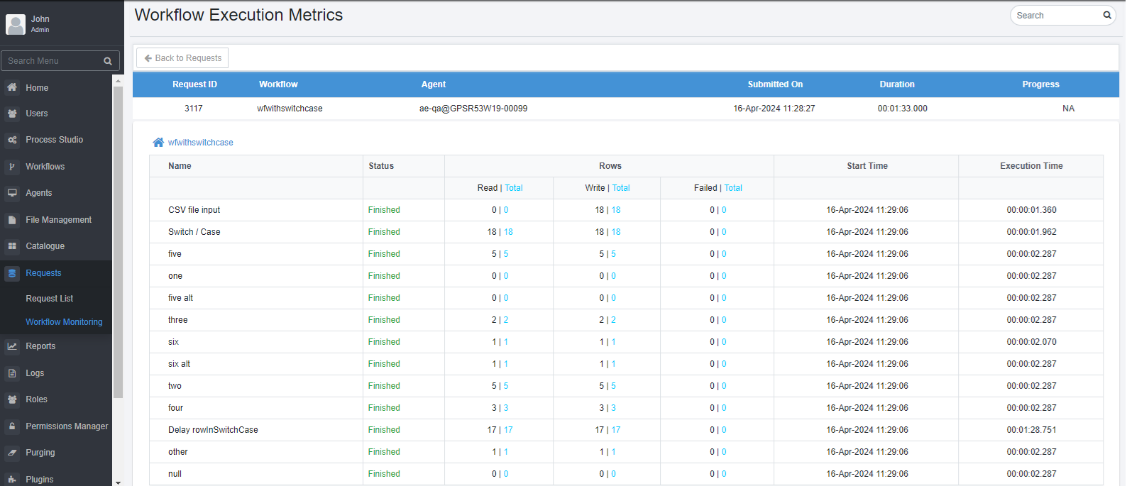Requests
This Requests menu shows a list of all the submitted workflow execution requests (latest on the top). You can also see details of these requests.
A user can only see those requests to which the user has access. An agent assigned with an execution thread will always check if a sequential request is available for execution. If yes, then the agent will first execute the sequential request and then work on the non-sequential requests. For example, an agent has four execution threads. The agent makes a call to the server for workflow execution requests. The server checks for a sequential request and:
- If yes, then it returns one sequential and three non-sequential requests.
- If no, then it returns all four non-sequential requests.
Viewing Request Details
View the status of submitted requests on the requests menu.
-
From the Columns field on the extreme right, you can choose the columns to see.
-
Three navigation options are available at the top and bottom of the Request Details section to select the number of rows per page in th Size field. There are scrolling options for First Page, Previous Page and Next Page.
-
View Request details (Id, Workflow Name, Status, Agent name, Source, Source ID, Submitted By, creation and completion times, as well as,an additional column Exception Start Time, six additional output attributes (Attribute1 to Attribute6) and six additional input attributes (Input Attribute1 to Input Attribute6)). Map Output Attributes to workflow output parameters, and Input Attributes to workflow input parameters. Input Attribute 1 has been mapped to Remedyforce Service Request ID.
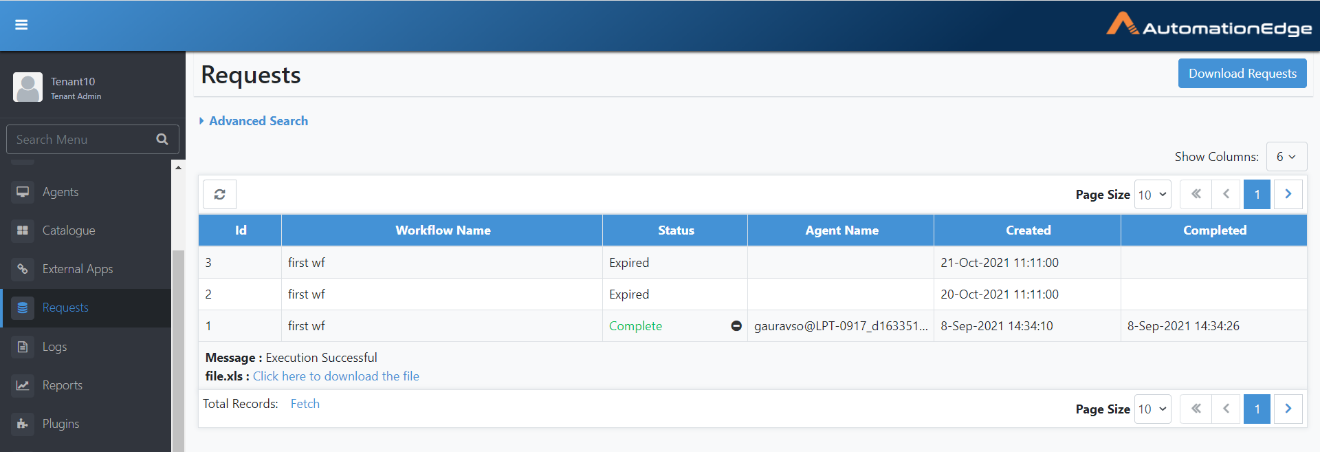
Figure 10.1: Viewing Request Details
Note:
-
If there is an output parameter type hyperlink in the workflow, then you will see a link if the validations are fulfilled, else you will see a message, respectively. See the following screenshot:
Example 1:
param2: if the validation is fulfilled, you will see the link to the external site. Click the link and you will get redirected to the site, which will open in a new tab.
param3: if the validation is not fulfilled, the link is removed and you will see the message informing why the link was removed.
If there is an output parameter type AE-AppLink in the workflow, then you will see a button or message, respectively. See the following screenshot:
Example 2:

Param1: if the validation is fulfilled, you will see the app button. Click the button and you will get redirected to the AE app, which will open in a new tab.
However, if the validations are not fulfilled, you will see a message informing you that the app does not exist.
For details about AE app, see AE Apps.
For more details about configuring the output parameters using hyperlink or AE-AppLink option, see Set Workflow Result step Plugin Reference Guide 2.
- Click Fetch to view the total records.
Table 10.1: View Request Details Field Descriptions
| Field Name | Description |
|---|---|
| ID | Displays request ID number. |
| Workflow Name | Displays workflow name. |
| Status | Displays request status and message description (Message description appears when |
| AutomationEdge has a set of states of a workflow like "New", "Execution Started", "Complete", "Diverted", and "Failure". The status can also be "Expired" or "Terminated". | |
| If the workflow requires manual intervention due to the inclusion of the Manual Intervention step in the workflow, then the status of the request changes to "Awaiting Input". The workflow execution will continue after the user has performed the required action, and the status changes to "Execution Started". | |
| In addition, in long-running workflows using 'Intermediate Status Step', set a user-defined intermediate message as described below in the section Elaboration of Status. | |
| If a workflow is in Failure Status, there is a restart icon ( ) next to the ( | |
| A Terminate icon ( | |
| Note: Workflow is not marked as a failure if output file upload fails from agent onto Server. It considers the result received from workflow execution. | |
| Agent Name | Displays the name of the agent |
| Source | Displays the request source from where the request is received |
| Note: Source column displays 'Scheduler: <schedule name>' if a scheduler triggers a Request. | |
| Source ID | |
| Submitted By | Displays the name of a person who has submitted the request. |
| Created | Displays request creation date & time. |
| Completed | Displays request completion date & time. |
| Attribute1 Attribute2 Attribute3 Attribute4 Attribute5 Attribute6 | - In these six Attribute columns provided retrieve any extra workflow information. - These values can be set from the 'Set Workflow Result' step in the 'AutomationEdge Core' category in Process Studio workflows. - The values of these attributes can be set from in-stream field, variable or as a constant. |
| Input Attribute1 | - Map Input Attributes to input parameters (e.g. |
| Input Attribute2 | ITSM systems: Remedyforce "task id" Remedy, |
| Input Attribute3 | "workorder id" or any other Source /Target |
| Input Attribute4 | System) |
| Input Attribute5 | |
| Input Attribute6 | - Input Attribute 1 is mapped to Remedyforce Service Request ID |
You can also view the workflow execution metrics, if required. For more information, see Workflow Monitoring.
In the Requests page, click ID link of the request for which the Workflow Monitoring feature is enabled. The link is available only if the Enable Workflow Monitoring checkbox in the Update Workflow page is selected.
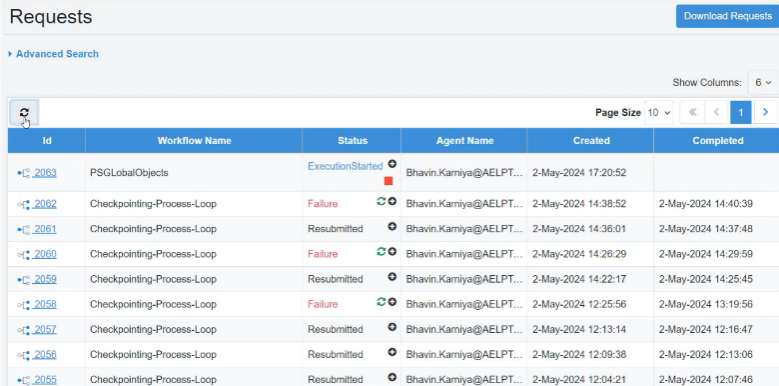
Elaboration of Request (/Workflow) Status
New
A request is yet to be picked up by an Agent; the Request status is set to New.
Execution Started
Set the status as 'Execution Started' if an Agent has picked up the request. Specify one or more intermediate statuses in workflows to customize the Current State of running Workflows.
Complete
Set the Request Status as Complete; if the workflow completes.
Failure
AE workflow may fail due to various reasons. Categorize Workflow Failure Reasons for failures into a few categories that may help the user better understand and report.
These failure categories are not visible on UI but view them in the Failure description.
Following are a set of predefined failure reasons:
-
License Expired
-
Invalid Request parameters
-
Invalid Credentials (expired etc.)
-
Invalid Workflow Definition
-
Agent Stopped/Restarted
-
Failed to connect to an external system
-
Authentication to external system failed
-
Workflow failed due to internal reason
-
Error while uploading/downloading file with server
-
Unknown reason
Table 10.2: Common Workflow Failure Reasons and System Response
| No. | Workflow Failed Due to | Failure reason |
|---|---|---|
| 1 | License/Subscription expired | Mark Workflow with the reason (1). |
| 2 | Invalid workflow parameter values,values that are not allowed | Mark Workflow with the reason (2). |
| 3 | Credential/Credential Pool deleted which is in use | Mark Workflow with the reason (2). |
| 4 | Credential has expired which is in use | Mark Workflow with the reason (2). |
| 5 | Resources not found at the location as specified in "resourceFolderPath" attribute in manifest | Mark Workflow with the reason (4). |
| 6 | Manifest parameters updated/removed | Mark Workflow with the reason (4). |
| 7 | Manifest action removed | Mark Workflow with the reason (4). |
| 8 | Execution/CheckStatus Script names modified or removed | Mark Workflow with the reason (4). |
| 9 | Workflow marked as failure because of agent stopped/restarted while running workflow | Mark Workflow with the reason (5). |
| 10 | Workflow could not connect to external system due to network or other error | Mark Workflow with the reason (6). |
| 11 | Authentication to external systems failed | Mark Workflow with the reason (7). |
| 12 | Process Studio Workflow failed | Mark Workflow with the reason (8). |
| 13 | Could not download input file from AE server from Agent (URL in agent.properites is wrong) | Mark Workflow with the reason (9). |
| 14 | Could not upload output file onto AE server from Agent (URL in agent.properites is wrong) | Mark Workflow with the reason (9). |
| 15 | Workflow failed due to unknown/unexpected reasons | Mark Workflow with the reason (10). |
Expired
This status is applicable for requests that an Agent does not pick up for execution and the status remains as New. Such requests are subject to 'cleanup requests' execution after elapse of several hours as set in the workflow configuration or System Settings for sysadmin users. Such requests are marked as 'Expired'.
Diverted
Set the Request status as diverted using the Set Workflow Result workflow step or process entry. It is for requests that have to be diverted outside AutomationEdge as the issue is beyond the purview of AutomationEdge.
Intermediate Status
If a workflow runs for a long duration, then there is no information on the server regarding the state of a running workflow. In this case, Process Studio step "Intermediate Status" can send the intermediate status to AE Server. The step has a free textbox where the user can set the status like % of completion or any other user-defined status. The status displays on the UI, in addition to the six states mentioned in the table above.
Terminated
Requests manually terminated by Admin or Workflow Administrator in case of long-running requests are marked with status 'Terminated'. It is elaborated in the section "Manual Termination of Request/Workflows" below.
Retry
The request status appears as Retry, when requests try again-and-again to borrow credentials from the Credential Pool for workflow execution, however, credentials are unavailable in the pool. Following are the scenarios when the user may see the Retry status:
-
All the existing credentials from the pool are already in use by other requests, which means, the Tenant Admin may need to add more credentials to the pool as per the request generation load.
OR -
All the existing credentials from the pool are expired.
Resubmitted
A request has been resubmitted for execution after failure.
Note: The status is only applicable or visible to the tenant having CONSUMPTION type of a license. If failed request is restarted for execution, then parent request status is changed to "Resubmitted" and AE Server creates a new request.
Awaiting Input
If the workflow requires manual intervention due to the inclusion of the Manual Intervention step in the workflow, then the status of the request changes to "Awaiting Input".
Manual Restart of Requests/Workflows
For all the failure reasons, a manual restart of a workflow is allowed. A workflow can restart only if it is in a failure state.
When running again, the workflow will take the same runtime parameters. If configuration parameters values change between failure and restart, it takes the updated configuration parameters while restarting. It runs with the same instance id as before.
Workflows can be restart if,
-
It has failed
-
It's in an enabled state
-
It's not modified after the failure
Manual Termination of Requests/Workflow
Manual termination of Requests/Workflows is a mechanism to terminate long-running or stuck workflows manually. The Termination option will be available once the expected execution time elapses.
This option is to terminate the workflow once the workflow execution starts on the agent. On the "Requests" page, there will be a button to execute this feature. Once clicked, it will send a signal to the agent to terminate the corresponding workflow.
TENANT_ADMIN and WORKFLOW_ADMIN users have access to terminate all the workflows of their tenants. Request owner (TENANT_USER) can terminate its workflows.
This feature is enabled only when a workflow is in the status 'ExecutionStarted'.
Note: Some steps/entries might remain "Halting" even if the workflow's main process terminates.
Manual Termination of Requests: Use Cases
Table 10.3: Use Cases for Manual Termination of Requests
| User Action | Conditions | System Response |
|---|---|---|
| Invoke Workflow termination | Workflow is in a state other than ExecutionStarted | API will return an error message |
| Invoke Workflow termination | Workflow is in the "ExecutionStarted" state | Workflow's main process terminates |
| Invoke Workflow termination | Workflow has Audit log steps used. | It uploads the Audit logs on the server, and the workflow's main process terminates |
Searching Requests
To search request:
-
Navigate to the Requests menu.
-
Click Advanced Search. The Column Name field is displayed.
-
Once a value is selected, the Criterion field is enabled. Select from the drop-down list.
-
Next, the Search Phrase field is displayed. Provide a phrase for Advanced Search.
-
Click the Add Filter button to add the filter. You can add more filters, if required.
-
Click Search. The search result based on the filter criteria is displayed.
-
Click Remove Filters to clear the filter criteria.
-
For convenience, save Advanced Filter with column selection on the Requests page along with filtered records as a view. If you perform an Advanced search on Requests Page in AutomationEdge UI and the current window is closed or reloaded, the Requests page still shows filtered data, and the Advanced Search filters are saved and shown above the Requests table as a view.
Note: Below is a description of the Advanced search options for Requests,
The table below summarizes the column names and corresponding comparators available for Advanced Search for Requests.
Table 10.4: Advanced Search filter criteria
| Column | Comparator | Value |
|---|---|---|
| - ID | - equal to | Specify a value for the ID and Comparator filter criteria. |
| - not equal to | ||
| - less than | ||
| - greater than | ||
| - in range | ||
| - not in range | ||
| - Workflow Name | - equal to | Specify a value for the Column and Comparator filter criteria. |
| - Status, | - not equal to | |
| - like | ||
| - Submitted By | - begins with | |
| - Source | - ends with | |
| - Source ID | ||
| - Agent Name | ||
| - six attributes | ||
| - six input attributes | ||
| - Dates | - exact date | Specify a value for the dates based on the Comparator selected |
| - before | ||
| - after | ||
| - in between | ||
| - not in between | ||
| - Priority | - equal to | Specify a value for the status based on the Comparator selected. |
| - not equal to |
Download Requests
Use Download Requests Button to download request pages in csv format.
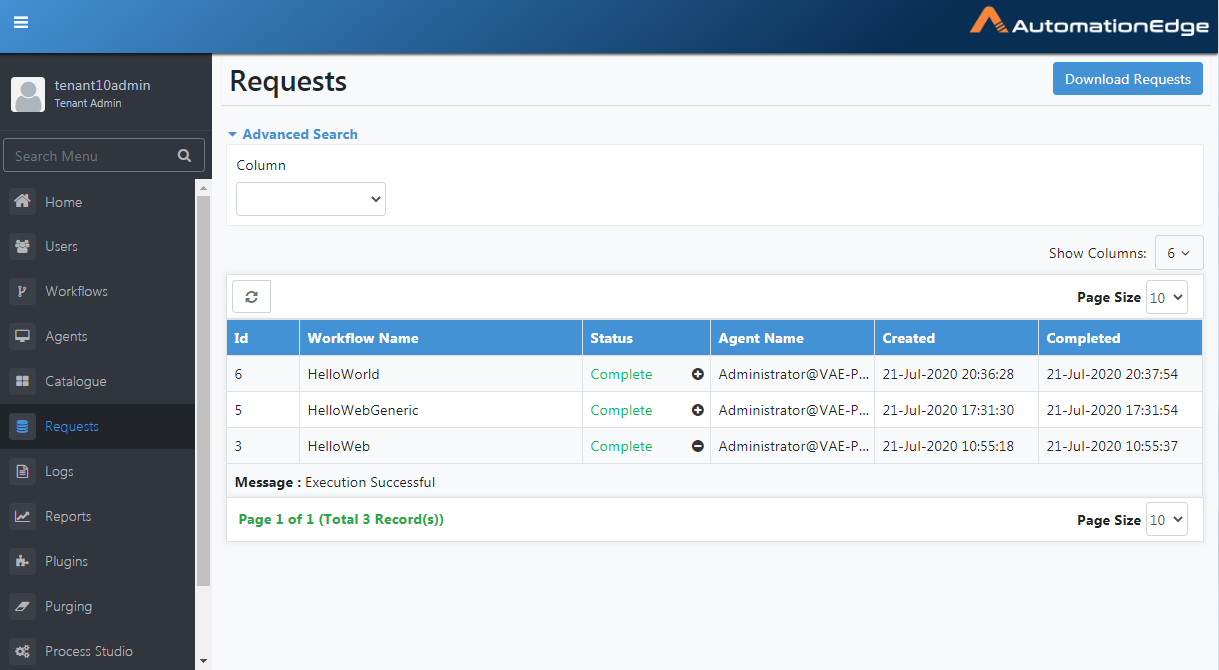
Figure 10.2: Requests
On Clicking the Download Requests button, a popup appears as below. Select the page number and click Download to download a CSV file.
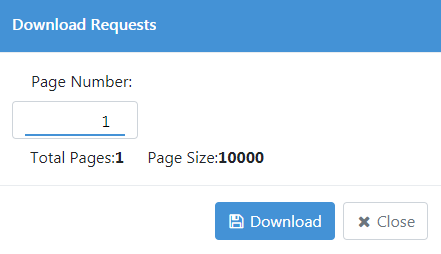
Figure 10.3: Total Download Pages
Requests: Features/Permissions for other users
Table 10.5: Requests Features
| Feature/Role | Admin | Workflow Administrator | User Administrator | Agent Administrator | Tenant User | Act Monitor |
|---|---|---|---|---|---|---|
| View Requests | ✔ | ✔ | - | - | ✔ | ✔ |
| Search Requests | ✔ | ✔ | - | - | ✔ | ✔ |
Workflow Monitoring
As your automation workflows become more complex and time-consuming, keeping track of their progress is essential. The Workflow Monitoring feature addresses this need by providing a comprehensive view of workflow executions. You can monitor ongoing jobs, review the history of completed workflows, and identify potential bottlenecks or errors. Two viewing options are available: a tabular view and a graphical view on the Workflow Execution Metrics page.
Important: To use the feature, ensure the following:
- In the ae.properties file, configure ae.workflow.monitoring.enabled = true. For more information, see AutomationEdge Installation Guide.
- Setup the workflow monitoring microservice. For more information, see the Workflow Monitoring Deployment Guide.
To view workflow execution metrics:
- Click Requests 🡪 Workflow Monitoring. The Workflow Execution Metrics page appears.
- View the following field details:
| Field Name | Description |
|---|---|
| Request Id | Displays the selected request ID. |
| Workflow | Displays the workflow name. |
| Agent | View the name of the agent. |
| Submitted On | Displays the date of request submission. |
| Duration | Displays the duration of workflow execution. |
| Progress | Displays the progress of child workflows or processes. |
| Name | Displays the name of step or entry or childworkflow or process. |
| Status | Displays the execution status of the step or entry or child workflow or process. |
| Rows | Displays the read, write, or failed step or entryor child workflow or process. |
| Start Time | Displays the execution start time of the step or entry or child workflow or process. |
| Execution Time Displays the total execution time of the step or entry or child workflow or process. |
Sample Child workflow or process monitoring



To work with graph view:
You cannot view the details of a child process or workflow in the graph view.
- In the Workflow Execution Metrics page, click the Graph tab. The Graph View appears.
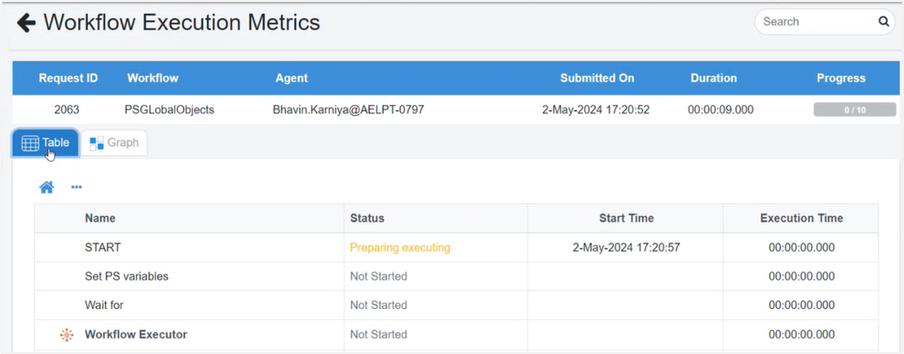
- In the Graph view see the following:
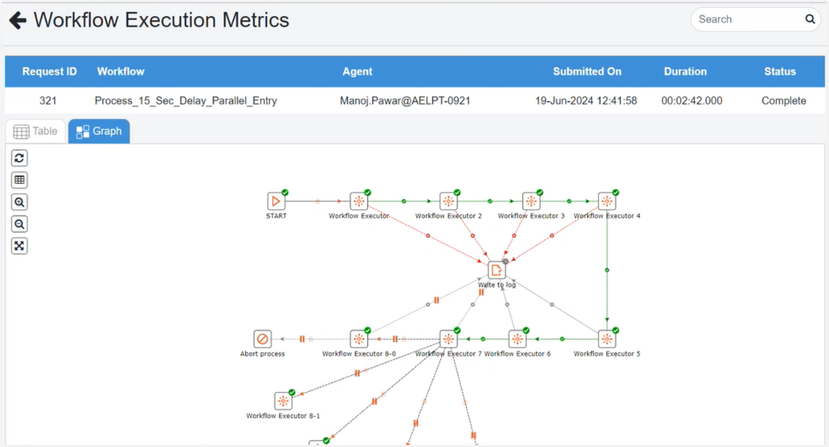
Note: For live monitoring, if the main file of the workflow is a process file, then you can choose to see the progress in the form of table or graph.
- To view the live monitoring of the workflow, click the Graph tab. You will see the progress as follows:
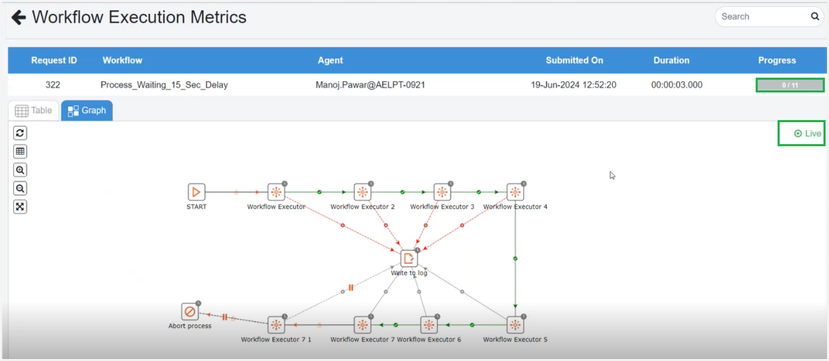
The Progress column displays the number of steps that are completed in the workflow execution. The following icons indicate various stages of the steps:
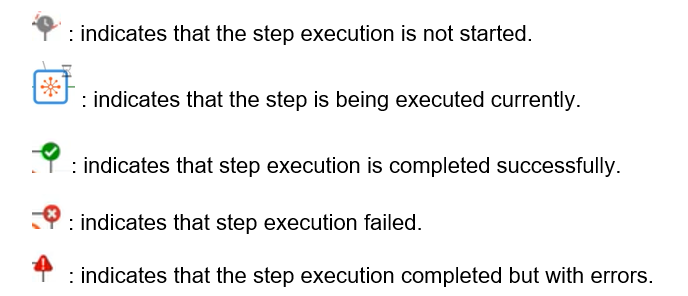
After the workflow execution is completed Status column is displayed instead of the Progress column.

Additional information:
- You can use the following tools to:
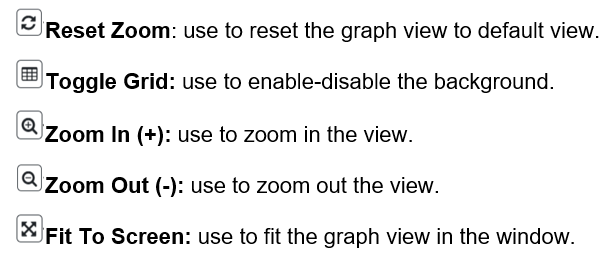
- Hover the mouse over a entry to view the following details:
- Status: If the step execution is started, completed, failed, and skipped. The Skipped status will be visible only if you select specific point from which to restart the execution.
- Start Time: Displays the time when the step execution started.
- End Time: Displays the time when the step execution completed.
- Execution Time: Displays the time taken to complete the step execution.

